400 AD to c. 950 AD
Gudehovet: The Heathen Hof
at Ranheim, Norway
Discovered 2010
[HOME]
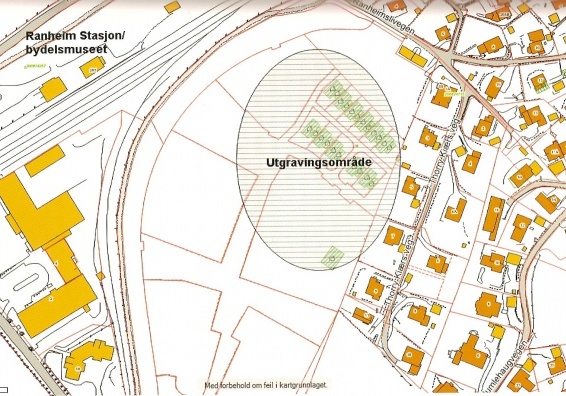 Map of the Surrounding Area Utgravingsområde: Excavation Site Area Artist: Kari Støren Binns. |
||
|
In 2011, a heathen hof (Gude Hovet) was
discovered by chance within a housing construction site at Ranheim
in Sør-Trøndelag, about 10 km north of Trondheim. The discovery
is the first ever made in these latitudes. Pre-Christian
cult sites in Scandinavia, often consisting of settlements with
a large central hall and a smaller attached building have
been discovered in eastern Denmark, Central and Southern Sweden
(Skåne), but not in Norway. The Hof may have been built sometime around the year 400 AD, and thus been in use for hundreds of years. The site was disassembled and buried under a thick layer of peat moss, around the time Christianity became the dominant religion in the area. The pagan sanctuary survived because the people who used it more than 1000 years ago, hid the entire complex under an unusually thick layer of soil, so thick that a plow could never reach deep enough to destroy it. Earlier, drainage ditches had been dug through the area, but without detecting what lay to the right and left of the trenchs. Thanks to the quality of the soil, the temple was preserved remarkably well. |
||
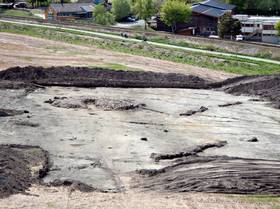 The fully excavated Hof in the form of the circular stone setting with an opening. The earthen wall to the rear shows how thick layers of soil were once placed over the temple to conceal it. (Photo: Preben Rønne) |
||
|
When archaeologists began the excavation, they initially thought it was a flat burial mound with a main pit and one or more secondary graves. But as they went, a rough heap emerged. Near the center of the site, they acknowledged that it was not a burial mound, but a sacrificial altar, called a hörg, in Old Norse sources. According to Preben Rønne of the Science Museum/NTNU in Trondheim, who led the excavations, the find was also easy to interpret as a pagan temple from Norse sources. The Hof site consists of a stone "altar", traces of a pole building which probably housed idols in the form of poles with carved faces, and a procession route. The youngest dating of the site is from the years 895 and 990 AD, precisely the time Christianity was introduced by heavy-handed means in Norway. Around this time, many people migrated to Iceland or other North Atlantic islands. The largest exodus of people who would retain their freedom and not allow themselves to be coverted to the new religion occurred from the Trøndelag area. Between AD 870 and 930, the largest part of them migrated to Iceland. In all, 40 people are specifically mentioned as hailing from Norway in the Norse sources. In Iceland, their descendants later wrote a large number of these sources. That the stakes of the pole building were removed, and the "altar" carefully covered with peat and clay, during the transition to Christianity, suggests that the site was intentionally dismantled and buried, perhaps to avoid desecration. |
||
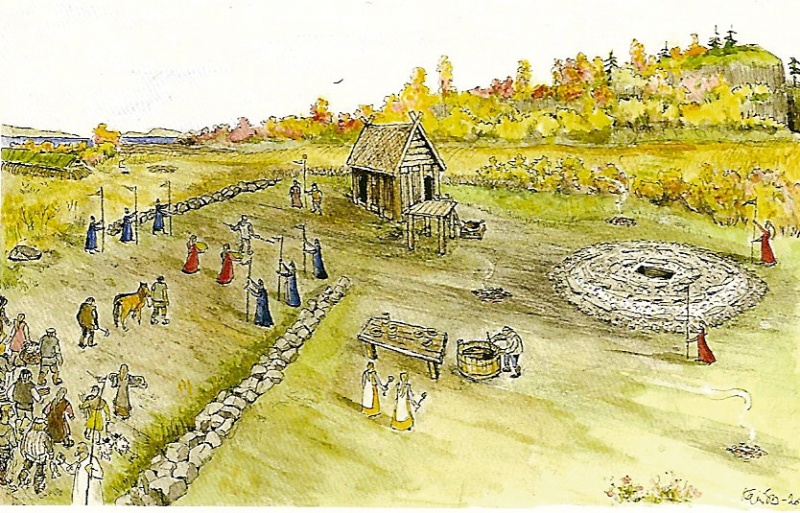 Conceptual Drawing of the Ancient Site Artist: Kari Støren Binns, 2011 |
||
|
The "altar" consisted of a flat circular stone about 15
feet in diameter and almost a meter high. A pole building a few
meters away was rectangular, 5.3 x 4.5 meters in the ground
floor and carried by 12 pillars, each with a heavy stone
foundation, indicating that it may have been tall. The building
was not used as a dwelling. Among other things, it had no
fireplace. Inside the house, traces of four posts, may be
evidence of a high seat. Occupied from the 5th or 6th until the 10th centuries AD, the site shows signs of animal sacrifice. Under the altar, a fire pit lays a directly on the prehistoric plow layer. The charcoal from this pit was dated to 400-500 AD. The site thus may have been regarded as sacred or at least had a special status long before the stone altar was built. In the prehistoric plow layer under the fire pit, traces of furrows made with an ard, the precursor to the plow, could clearly be seen. |
||
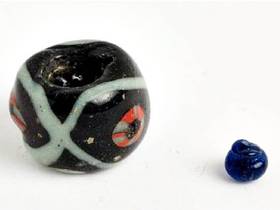 (Photo: Preben Rønne) |
||
|
Atop the sacrificial altar, two glass beads were
found during the excavation. Also discovered were some
burnt bones and traces of a wooden box that had been filled with
reddish gravel and broken boiling stones. Among the bones, a
human skull and several human teeth were identified. The Procession Road west of the temple, headed straight to the pole building, was marked with two parallel rows of large stones, the longest run at least 25 feet long. Evidence indicates that the people who deliberately covered the temple at Ranheim, took the stakes from the house with them — perhaps to the place where they settled in order to raise a new heathen temple. |
||
|
In the Eyrbyggja saga, ch. 2-4, we find a similar scene: "Bjorn boarded a skiff he owned, taking his household and goods with him, and sailed south along the coast of Norway. ...He sailed until he came to the island of Moster, which lies off of southern Hordaland, and there was received by a man named Hrolf. "...Thorolf then sailed out to sea with a fair wind and came within sight of land sailing then west along the southern coast and around cape Reykjanes. The wind dropped and they could see on the shore where broad fjords cut into the land. Thorolf cast overboard the high-seat pillars which had been in his temple, one of which had Thor carved on it. Thorolf declared that he would settle in Iceland in whatever place Thor directed the pillars to land. As soon as the pillars were thrown overboard, they were swept towards the more westerly of the fjords and seemed to travel faster than might be expected. Because the findings fit so well together with the Norse sources, the sources are likely more reliable than many scientists now believe. |
||
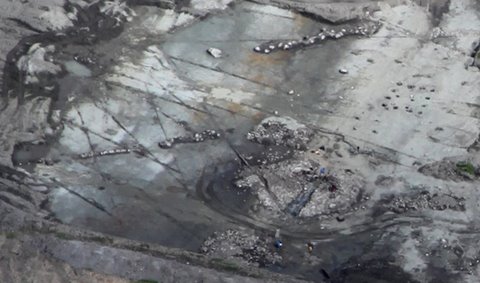 Aerial photo over Ranheim-utgravingen Summer 2010. Photo: NTNU Vitenskapsmuseet. |
||
|
The Ranheim sanctuary was permanently removed to make way for
housing. |
||
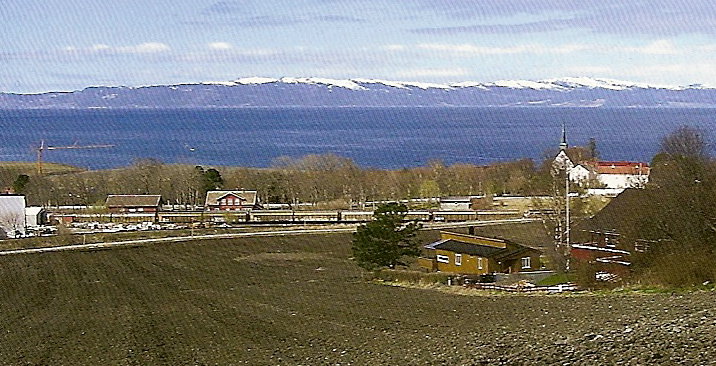 The Ranheim Site 2 December 2011 |
||
|
SOURCES: Aftenposten, 23 December 2011: "Fant hedensk helligdom uten sidestykke" FreeThought Nation, 16 March 2012: "Archaeologists unearth 'unparalleled' pre-Christian temple in Norway" |